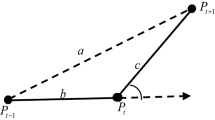Abstract
This paper presents an innovative hybrid approach for online recognition of handwritten symbols. The approach is composed of two main techniques. Firstly, fuzzy rules are used to extract a meaningful set of features from a handwritten symbol, and secondly a recurrent neural network uses the feature set as input to recognise the symbol. The extracted feature set is a set of basic shapes capturing what is distinctive about each symbol, thus making the network’s classification task easier. We propose a new recurrent neural network architecture, associated with an efficient learning algorithm derived from the gradient descent method. We describe the network and explain the relationship between the network and the Markov chains. The approach has achieved high recognition rates using benchmark datasets from the Unipen database.
Preview
Unable to display preview. Download preview PDF.
Similar content being viewed by others
References
Huang, B.Q., Rashid, T., Kechadi, T.: A New Modified Network based on the Elman Network. In: The IASTED Int’l. Conf. on Artificial Intelligence and Applications AIA 2004 (February 2004)
Elman, J.: Finding Structure in Time. Cognitive Science 14(2), 179–211 (1990)
Fitzgerald, J.A., Geiselbrechtinger, F., Kechadi, T.: Application of Fuzzy Logic to Online Recognition of Handwritten Symbols. In: The Ninth Int’l. Workshop on Frontiers in Handwriting Recognition (IWFHR 9), Tokyo, Japan, pp. 395–400 (2004)
Schomaker, L., Teulings, H.: A handwriting recognition system based on properties of the human motor system. In: The Int’l. Workshop on Frontiers in Handwriting Recognition (IWFHR), pp. 195–211 (1990)
Mitoma, H., Uchida, S., Sakoe, H.: Online character recognition using eigen-deformations. In: The 9th Int’l. Workshop on Frontiers in Handwriting Recognition (IWFHR 9), Tokyo, Japan, pp. 3–8 (2004)
Schenkel, M., Guyon, I., Henderson, D.: On-Line Cursive Script Recognition Using Time Delay Neural Networks and Hidden markov Models. In: Int’l. Conf. on Acoustics, Speech, and Signal Processing, vol. 2, pp. 637–640 (1994)
Williams, R.J., Zipser, D.: Gradient-based learning algorithms for recurrent networks and their computational complexity. Backpropagation: theory, architectures, and applications, 433–486 (1995)
Gomes, N., Ling, L.: Feature extraction based on fuzzy set theory for handwriting recognition. In: 6th Int’l. Conf. on Document Analysis and Recognition, pp. 655–659 (2001)
Fitzgerald, J.A., Geiselbrechtinger, F., Kechadi, T.: Feature Extraction of Handwritten Symbols Using Fuzzy Logic. In: The Seventeenth Canadian Conference on Artificial Intelligence (AI 2004), Ontario, Canada, pp. 493–498 (2004)
Yeung, D.Y., Yeung, K.W.: A locally recurrent neural network model for grammatical inference. In: Int’l. Conf. on Neural Information Processing, pp. 1468–1473 (1994)
Hu, J., Brown, M.K., Turin, W.: HMM Based On-Line Handwriting Recognition. IEEE Transactions on Pattern Analysis and Machine Intelligence 18(10), 1039–1045 (1996)
Trier, O.D., Jain, A.K., Taxt, T.: Feature extraction methods for character recognition - A survey. Pattern Recognition 29, 641–662 (1996)
Guyon, I., Schomaker, L., Plamondon, R., Liberman, M., Janet, S.: Unipen project of on-line data exchange and recognizer benchmarks. In: The 12th Int’l. Conf. on Pattern Recognition, pp. 29–33 (1994)
Williams, R., Zipser, D.: A learning algorithm for continually running fully recurrent neural networks. Neural Computation 1(2), 270–280 (1989)
Wilson, W.H.: Learning Performance of Networks like Elman’s Simple Recurrent Networks but having Multiple State Vectors. In: Cognitive Modelling Workshop of the Seventh Australian Conf. on Neural Networks (1996)
Author information
Authors and Affiliations
Editor information
Editors and Affiliations
Rights and permissions
Copyright information
© 2005 Springer-Verlag Berlin Heidelberg
About this paper
Cite this paper
Fitzgerald, J.A., Huang, B.Q., Kechadi, T. (2005). An Efficient Hybrid Approach for Online Recognition of Handwritten Symbols. In: Gelbukh, A., de Albornoz, Á., Terashima-Marín, H. (eds) MICAI 2005: Advances in Artificial Intelligence. MICAI 2005. Lecture Notes in Computer Science(), vol 3789. Springer, Berlin, Heidelberg. https://doi.org/10.1007/11579427_86
Download citation
DOI: https://doi.org/10.1007/11579427_86
Publisher Name: Springer, Berlin, Heidelberg
Print ISBN: 978-3-540-29896-0
Online ISBN: 978-3-540-31653-4
eBook Packages: Computer ScienceComputer Science (R0)




